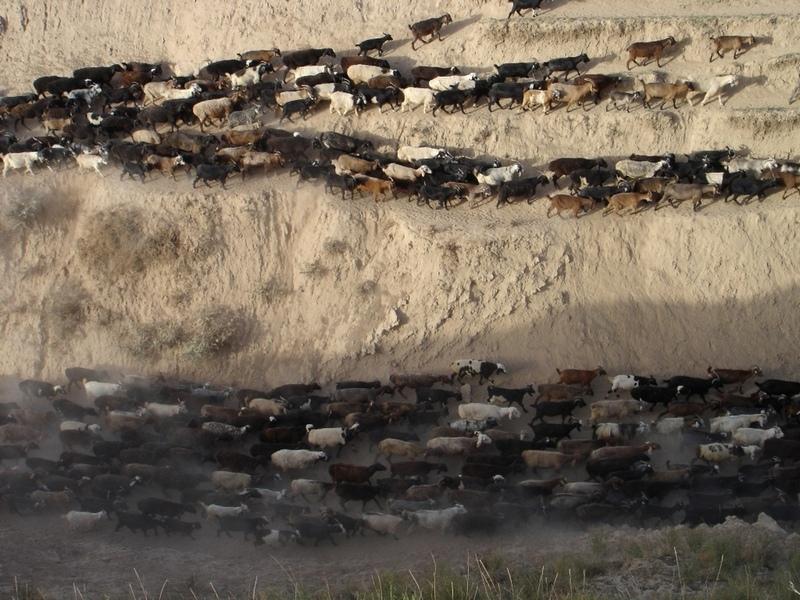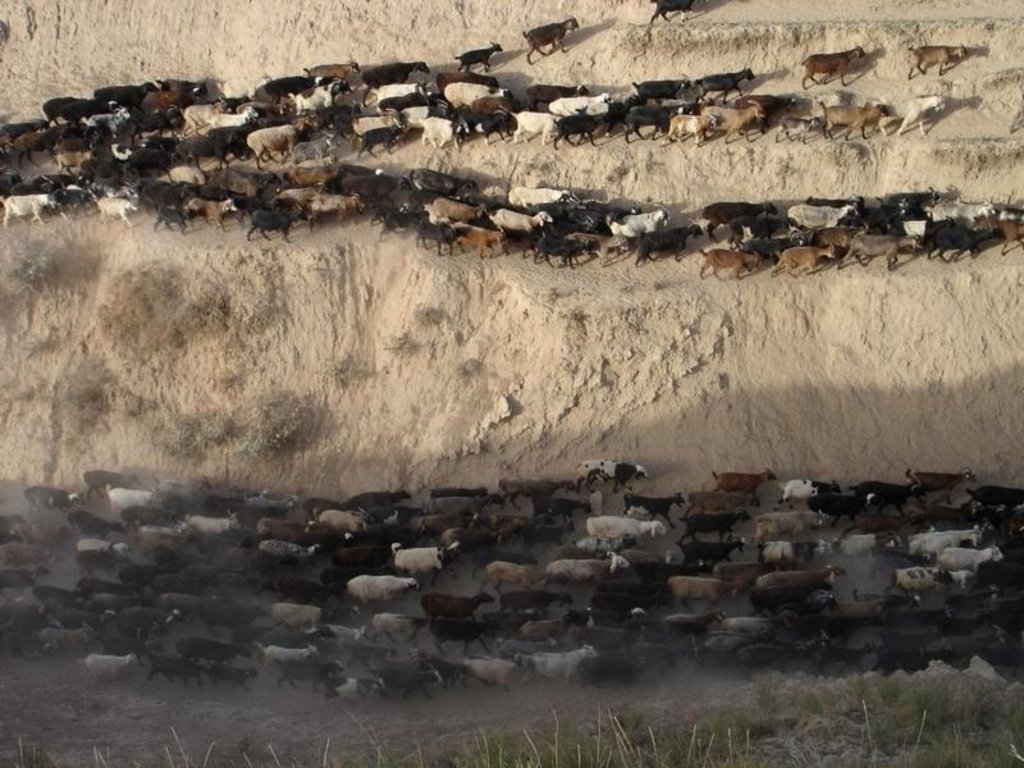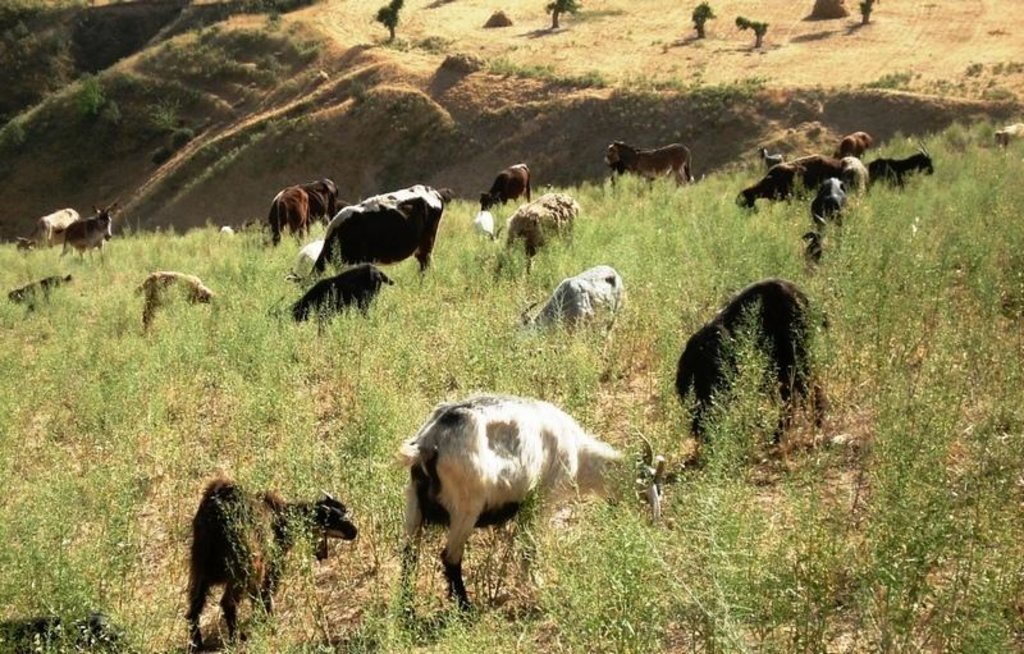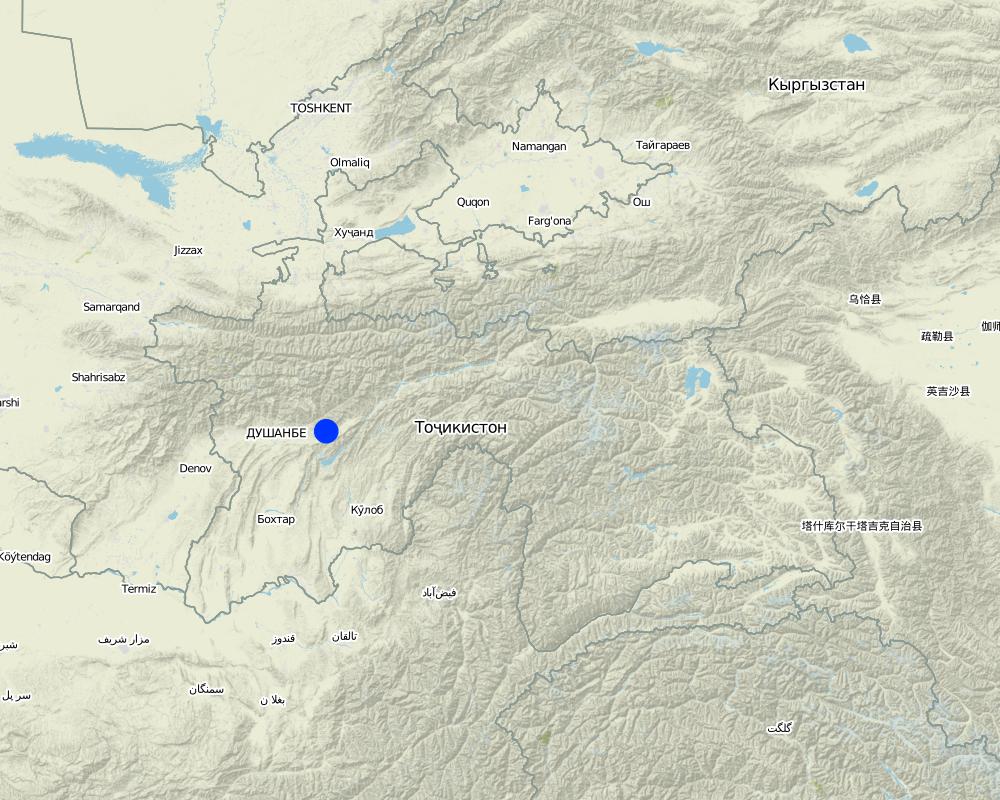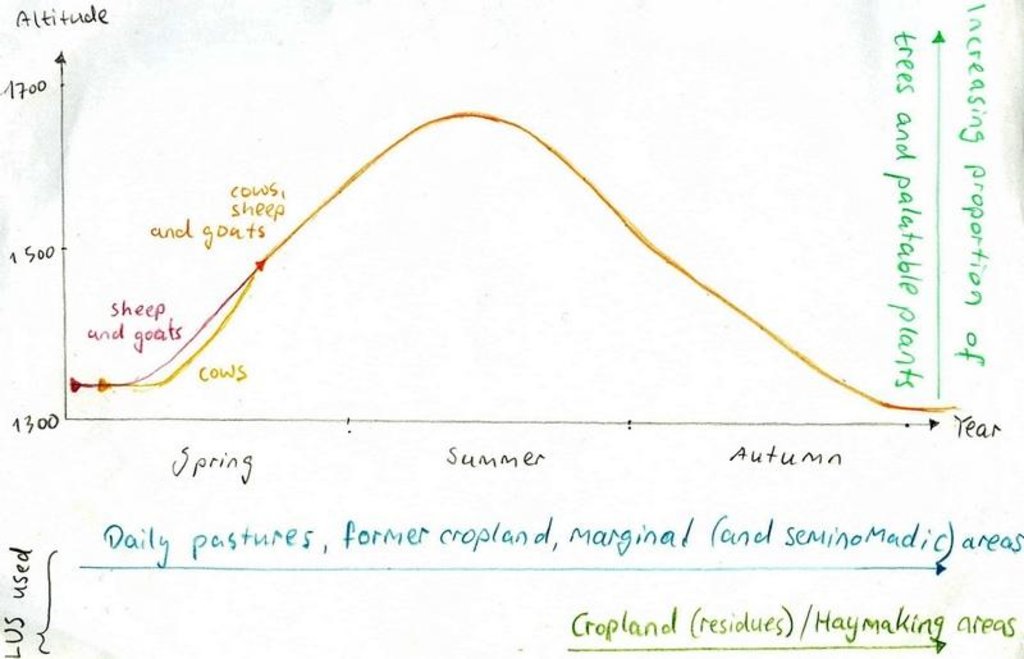Daily grazing of village-herds [ប្រទេសតាហ្ស៊ីគីស្ថាន]
- ការបង្កើត៖
- បច្ចុប្បន្នភាព
- អ្នកចងក្រង៖ Christian Wirz
- អ្នកកែសម្រួល៖ –
- អ្នកត្រួតពិនិត្យច្រើនទៀត៖ David Streiff, Alexandra Gavilano
Charogo bistumi (pasture for everyone)
technologies_1408 - ប្រទេសតាហ្ស៊ីគីស្ថាន
ពិនិត្យមើលគ្រប់ផ្នែក
ពង្រីកមើលទាំងអស់ បង្រួមទាំងអស់1. ព័ត៌មានទូទៅ
1.2 ព័ត៌មានលម្អិតពីបុគ្គលសំខាន់ៗ និងស្ថាប័នដែលចូលរួមក្នុងការវាយតម្លៃ និងចងក្រងឯកសារនៃបច្ចេកទេស
ឈ្មោះអង្គភាពមួយ (ច្រើន) ដែលបានចងក្រងឯកសារ/ វាយតម្លៃបច្ចេកទេស (បើទាក់ទង)
CDE Centre for Development and Environment (CDE Centre for Development and Environment) - ប្រទេសស្វ៊ីសឈ្មោះអង្គភាពមួយ (ច្រើន) ដែលបានចងក្រងឯកសារ/ វាយតម្លៃបច្ចេកទេស (បើទាក់ទង)
NCCR North-South (NCCR North-South) - ប្រទេសកៀហ្ស៊ីស៊ីស្ថាន1.3 លក្ខខណ្ឌទាក់ទងទៅនឹងការប្រើប្រាស់ទិន្នន័យដែលបានចងក្រងតាមរយៈ វ៉ូខេត
អ្នកចងក្រង និង(បុគ្គលសំខាន់ៗ)យល់ព្រមទទួលយកនូវលក្ខខណ្ឌនានាទាក់ទងទៅនឹងការប្រើប្រាស់ទិន្នន័យដែលបានចងក្រងតាមរយៈវ៉ូខេត:
បាទ/ចា៎
1.5 ការយោងទៅលើកម្រងបញ្ជីសំណួរ (មួយ ឬច្រើន) នៃវិធីសាស្ត្រផ្សព្វផ្សាយ SLM (ដែលបានចងក្រងដោយទស្សនៈពិភពលោកស្តីពីវិធីសាស្ត្រ និងបច្ចេកទេសងអភិរក្ស WOCAT)
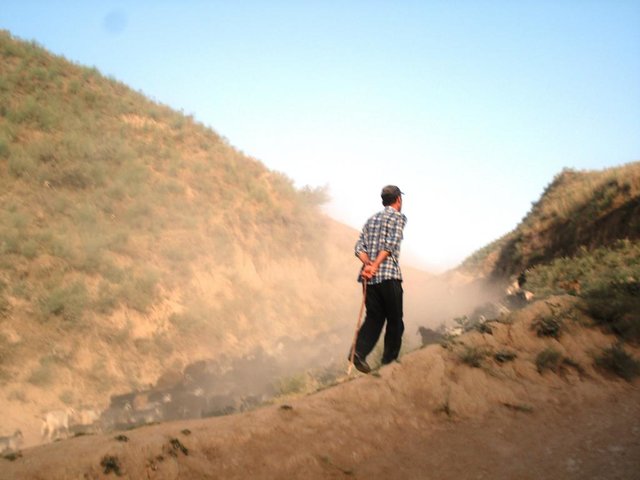
Common village herding [ប្រទេសតាហ្ស៊ីគីស្ថាន]
Village herding system with daily alternation of the herders including each household in a monthly turnus.
- អ្នកចងក្រង៖ Christian Wirz
2. ការពណ៌នាពីបច្ចេកទេស SLM
2.1 ការពណ៌នាដោយសង្ខេបពីបច្ចេកទេស
និយមន័យបច្ចេកទេស:
Rotational grazing on village pastures with heavy pressure with daily to weekly change of grazing places.
2.2 ការពណ៌នាលម្អិតពីបច្ចេកទេស
ការពណ៌នា:
The herding season is from the beginnning of March to the End of Octobre or even beginning of Decembre. Total area is between 10-20 km2, depending on how strictly the borders are understood. Cows, sheep, goats and donkeys compose the herds. Grazing begins when soil moisture begins to decreaset, first with the little animals, that are supposed to better cope with slippery conditions. After two weeks the cows are led to the pastures and in some cases they will be grazed alone, because sheep and goats disturb them. The grazing zone is situated between 1400 and 1700 m. Rotation begins on the lower pastures, at the beginning of summer the higher pastures are used and towards autumn the animals graze near the villages again, sometimes on cropland, feeding on crop residues. The herders are advised to change place after 2-3 days, but often stay in one place for a longer time. The animals are gathered on the way out of the village a little after dawn, than brought to the pastures. At noon-time they will be lead to a shady place close to a stream, if possible. The same places are visited three or more times per season.
Purpose of the Technology: The animals should be nourished and the cows should give milk. A land user kept his cow at home towards the end of summer, because it stopped giving milk, from the sparse and dry vegetation on the pastures.
Establishment / maintenance activities and inputs: The costs for this form of herding are lost days at school for the children. It largely works without external inputs (such as fertilisers). Other inputs such as salt for the animals are covered by the landowner.
Natural / human environment: These pasture-areas are heaviliy suffering from overuse on one hand and from droughts on the other side. They are in a generally well-conserved state. Fractional vegetation cover is low, especially tree cover, and the proportion non-palatable species relatively high. Erosion by water, including gullies, and crusting, are common phenomena, especially in low cover areas.
2.3 រូបភាពនៃបច្ចេកទេស
2.5 ប្រទេស/តំបន់/ទីតាំងកន្លែង ដែលបច្ចេកទេសត្រូវបានអនុវត្ត និងបានគ្រប់ដណ្តប់ដោយការវាយតម្លៃនេះ
ប្រទេស:
ប្រទេសតាហ្ស៊ីគីស្ថាន
តំបន់/រដ្ឋ/ខេត្ត:
Region of Republican Subordination
បញ្ជាក់បន្ថែមពីលក្ខណៈនៃទីតាំង:
Faizabad
បញ្ជាក់ពីការសាយភាយនៃបច្ចេកទេស:
- ត្រូវបានផ្សព្វផ្សាយត្រឹមតំបន់មួយ
ប្រសិនបើមិនច្បាស់ពីទំហំផ្ទៃដី សូមធ្វើការប៉ាន់ប្រម៉ាណ:
- 10-100 គម2
មតិយោបល់:
Total area covered by the SLM Technology is 15 km2.
For some villages figures are available, for instance for Karsang: This village has alltogether 850 ha of common grazing land, for officially 212 cows and 775 little animals. For the whole Jamoat the figures are of around 2500 ha of pasture-land (not all in the study-area) for 2695 cows and 5950 little animals.
Map
×2.6 កាលបរិច្ឆេទនៃការអនុវត្ត
ប្រសិនបើមិនច្បាស់ឆ្នាំ សូមបញ្ជាក់កាលបរិច្ឆេទដែលប្រហាក់ប្រហែល:
- ច្រើនជាង 50 ឆ្នាំមុន (ប្រពៃណី)
2.7 ការណែនាំពីបច្ចេកទេស
សូមបញ្ជាក់តើបច្ចេកទេសត្រូវបានណែនាំឱ្យអនុវត្តដោយរបៀបណា:
- ជាផ្នែកនៃប្រព័ន្ធប្រពៃណី (> 50 ឆ្នាំ)
មតិយោបល់ (ប្រភេទនៃគម្រោង ។ល។):
Already before the USSR the villages used to have their hamlets and grazed them around the villages, but also in the formerly not very populated plains. By the settlement of people in the plains and population growth from the 1970ies onward livestock numbers and pressure on natural resources started to increase there. And through Soviet collective agriculture people were forced to keep livestock close to the villages, as a consequence of their employment. In addition, grazing on the territory of forest administration, founded in the 1960ies, was forbidden for the villagers.
3. ចំណាត់ថ្នាក់នៃបច្ចេកទេស SLM
3.2 ប្រភេទដីប្រើប្រាស់មួយប្រភេទ (ច្រើនប្រភេទ) ដែលបានអនុវត្តបច្ចេកទេស

ដីសម្រាប់ចិញ្ចឹមសត្វ
វាលស្មៅធំៗ:
- បែងចែកវាលស្មៅជាប្លុក
ប្រភេទសត្វ:
- សត្វពពែ
- សត្វចៀម
- cow, donkey
មតិយោបល់:
Livestock density (if relevant):
< 1 LU/km2
Major land use problems (compiler’s opinion): Soils are heavily degraded in the sense of generally high levels of compaction and crusting and low organic matter contents. Vegetation is especially reduced in cover, not necessarily in biomass and, the fraction of good pasture species is low.
Major land use problems (land users’ perception): Many trees have been cut down during civil war and till today, leaving back a soil without protection. Animals grazing on these pastures are not fat, often sick and cows give little and sometimes (in summer) no milk. An often mentioned problem is the situation of drought in 2008 and animals staying in one place for longer periods, which leads to degradation of vegetation.
Ranching: sheep and goats / cows and donkeys.
Grazingland comments: In spring sheep and goats are herded before cows, then in a separate herd and toward the end of the season, together.
Type of grazing system comments: In spring sheep and goats are herded before cows, then in a separate herd and toward the end of the season, together.
3.4 ការផ្គត់ផ្គង់ទឹក
ការផ្គត់ផ្គង់ទឹកនៅកន្លែងអនុវត្តបច្ចេកទេស:
- ទឹកភ្លៀង
មតិយោបល់:
Specify:
Longest growing period in days: 270Longest growing period from month to month: Oct - Jul
3.5 ក្រុម SLM ដែលបច្ចេកទេសស្ថិតនៅក្នុង
- កសិរុក្ខកម្ម (pastoralism) និងការគ្រប់គ្រងដីសម្រាប់ចិញ្ចឹមសត្វ
3.6 វិធានការ SLM ដែលបញ្ចូលនូវបច្ចេកទេស

វិធានការគ្រប់គ្រង
- M1: ការផ្លាស់ប្តូរប្រភេទដីប្រើប្រាស់
មតិយោបល់:
Main measures: management measures
3.7 កំណត់ប្រភេទនៃការធ្លាក់ចុះគុណភាពដីសំខាន់ៗដែលបច្ចេកទេសនេះបានដោះស្រាយ

ការហូរច្រោះដីដោយសារទឹក
- Wt: ការបាត់ដីស្រទាប់លើដោយការហូរច្រោះ
- Wg: ការកកើតឡើងនូវកំទេចកំទីដីស្រទាប់ក្រោម
- Wm: ការបាក់ដី

ការធ្លាក់ចុះជីវសាស្ត្រនៃដី
- Bc: ការថយចុះនូវគម្របរុក្ខជាតិ
មតិយោបល់:
Secondary types of degradation addressed: Wt: loss of topsoil / surface erosion, Wg: gully erosion / gullying, Wm: mass movements / landslides, Bc: reduction of vegetation cover
Main causes of degradation: overgrazing (Big livestock numbers on little surface.), poverty / wealth (People depend on livestock and on cheap pastures.)
Secondary causes of degradation: droughts (Many people mention that rainfalls were much lower in 2007-2008 than normally.), population pressure (Especially from the 1970ies onward population increased rapidly.), land tenure (As long as no-one is really responsible for the are, conservation measures are difficult to implement.), war and conflicts (Civil war was detrimental to the (little) economic, non-agricultural sector (textiles, car-parts) and to the institutions, so that many people had to return to agricultural activities.)
3.8 ការពារ កាត់បន្ថយ ឬស្តារឡើងវិញនៃការធ្លាក់ចុះគុណភាពដី
បញ្ជាក់ពីគោលដៅរបស់បច្ចេកទេស ដែលផ្តោតទៅការធ្លាក់ចុះគុណភាពដី:
- ការកាត់បន្ថយការធ្លាក់ចុះគុណភាពដី
មតិយោបល់:
Main goals: mitigation / reduction of land degradation
4. បច្ចេកទេសជាក់លាក់ សកម្មភាពអនុវត្ត ធាតុចូល និងថ្លៃដើម
4.1 គំនូសបច្ចេកទេសនៃបច្ចេកទេសនេះ
លក្ខណៈពិសេសនៃបច្ចេកទេស (ទាក់ទងនឺងគំនូរបច្ចេកទេស):
Rotation of the village herds.
Location: Karsang and other villages. Faizabad
Date: 20.08.09
Technical knowledge required for land users: low (The practiced rotation follows the humour of the herders (often children) and is not complicated.)
Secondary technical functions: improvement of surface structure (crusting, sealing), increase of biomass (quantity)
Change of land use practices / intensity level: The begin of grazing and the rotation is fixed by a village committee. Animals should not stay at one place for longer than 3 days.
ឈ្មោះអ្នកនិពន្ធ:
Christian Wirz, Switzerland
4.2 ព័ត៌មានទូទៅដែលពាក់ព័ន្ធនឹងការគណនាធាតុចូល និងថ្លៃដើម
ផ្សេងៗ/ រូបិយប័ណ្ណជាតិ (បញ្ជាក់):
Somoni
បើពាក់ព័ន្ធសូមកំណត់អត្រាប្តូរប្រាក់ពីដុល្លាទៅរូបិយប័ណ្ណតំបន់ (ឧ. 1 ដុល្លារ = 79.9 រៀលនៃរូបិយប័ណ្ណប្រេស៊ីល) ៖ 1 ដុល្លារ =:
3,42
4.3 សកម្មភាពបង្កើត
| សកម្មភាព | រយៈពេល (រដូវកាល) | |
|---|---|---|
| 1. | Villagers buy animals, usually 6-10 goats and / or sheep, 1-2 cows and / or donkeys. | Constantly size is regulated. |
4.4 ថ្លៃដើម និងធាតុចូលដែលត្រូវការសម្រាប់ការបង្កើតបច្ចេកទេស
| បញ្ជាក់ពីធាតុចូល | ឯកតា | បរិមាណ | ថ្លៃដើមក្នុងមួយឯកតា | ថ្លៃធាតុចូលសរុប | % នៃថ្លៃដើមដែលចំណាយដោយអ្នកប្រើប្រាស់ដី | |
|---|---|---|---|---|---|---|
| ផ្សេងៗ | buy the animals | per year | 1,0 | 1170,0 | 1170,0 | 100,0 |
| ថ្លៃដើមសរុបក្នុងការបង្កើតបច្ចេកទេស | 1170,0 | |||||
| ថ្លៃដើមសរុបក្នុងការបង្កើតបច្ចេកទេសគិតជាដុល្លារ | 342,11 | |||||
4.5 សកម្មភាពថែទាំ
| សកម្មភាព | ពេលវេលា/ ភាពញឹកញាប់ | |
|---|---|---|
| 1. | Per capita fee taxes | Once per year. |
| 2. | Buying concentrated feed, depending on the financial resources of the land user. | Bought once per year, for winter period. |
| 3. | Haymaking and / or buying, depending on labour, financial resources and livestock numbers. | June-July, respectively later, if bought. |
| 4. | Medecine and salt for animals | Irregularly, resp. daily to weekly. |
4.6 កំណត់ថ្លៃដើមសម្រាប់ការថែទាំ/ សកម្មភាពរបស់បច្ចេកទេស (ក្នុងរយៈពេលមួយឆ្នាំ)
| បញ្ជាក់ពីធាតុចូល | ឯកតា | បរិមាណ | ថ្លៃដើមក្នុងមួយឯកតា | ថ្លៃធាតុចូលសរុប | % នៃថ្លៃដើមដែលចំណាយដោយអ្នកប្រើប្រាស់ដី | |
|---|---|---|---|---|---|---|
| ផ្សេងៗ | Per capita fee taxes | per year | 12,0 | 1,0 | 12,0 | |
| ផ្សេងៗ | Buying concentrated feed | kg | 425,0 | 0,53 | 225,25 | |
| ផ្សេងៗ | Medecine and salt for the animals | for all animals | 1,0 | 45,0 | 45,0 | |
| ថ្លៃដើមសរុបសម្រាប់ការថែទាំដំណាំតាមបច្ចេកទេស | 282,25 | |||||
| ថ្លៃដើមសរុបសម្រាប់ការថែទាំដំណាំតាមបច្ចេកទេសគិតជាដុល្លារ | 82,53 | |||||
មតិយោបល់:
The calculated costs apply to each land user's cost for this herding system.
4.7 កត្តាសំខាន់បំផុតដែលមានឥទ្ធិពលដល់ការចំណាយ
ពណ៌នាពីកត្តាប៉ះពាល់ចម្បងៗទៅលើថ្លៃដើម:
The most important cost factor is buying livestock. Recurrent costs are low, but rent fees for pastures are percieved as being high.
5. លក្ខណៈបរិស្ថានធម្មជាតិ និងមនុស្ស
5.1 អាកាសធាតុ
បរិមាណទឹកភ្លៀងប្រចាំឆ្នាំ
- < 250 មម
- 251-500 មម
- 501-750 មម
- 751-1,000 មម
- 1,001-1,500 មម
- 1,501-2,000 មម
- 2,001-3,000 មម
- 3,001-4,000 មម
- > 4,000 មម
តំបន់កសិអាកាសធាតុ
- មានភ្លៀងតិចតួច
Thermal climate class: subtropics
5.2 សណ្ឋានដី
ជម្រាលជាមធ្យម:
- រាបស្មើ (0-2%)
- ជម្រាលតិចតួច (3-5%)
- មធ្យម (6-10%)
- ជម្រាលខ្ពស់បន្តិច (11-15%)
- ទីទួល (16-30%)
- ទីទួលចោត (31-60%)
- ទីទួលចោតខ្លាំង (>60%)
ទម្រង់ដី:
- ខ្ពង់រាប
- កំពូលភ្នំ
- ជម្រាលភ្នំ
- ជម្រាលទួល
- ជម្រាលជើងភ្នំ
- បាតជ្រលងភ្នំ
តំបន់តាមរយៈកម្ពស់ :
- 0-100 ម
- 101-500 ម
- 501-1,000 ម
- 1,001-1,500 ម
- 1,501-2,000 ម
- 2,001-2,500 ម
- 2,501-3,000 ម
- 3,001-4,000 ម
- > 4,000 ម
មតិយោបល់ និងបញ្ចាក់បន្ថែមអំពីសណ្ឋានដី :
Altidudinal zone: Most pastures are close to the villages, on around 1300-1500 m, but some pastures reach altitudes of 1600-1700 m.
Landforms: The pasture-areas usually follow N-S-ridges and most pastures are in slope-areas.
Slopes on average: Also hilly
5.3 ដី
ជម្រៅដីជាមធ្យម:
- រាក់ខ្លាំង (0-20 សម)
- រាក់ (21-50 សម)
- មធ្យម (51-80 សម)
- ជ្រៅ (81-120 សម)
- ជ្រៅខ្លាំង (> 120 សម)
វាយនភាពដី (ស្រទាប់លើ):
- មធ្យម (ល្បាយ, ល្បាប់)
សារធាតុសរីរាង្គនៅស្រទាប់ដីខាងលើ:
- ទាប (<1%)
បើអាចសូមភ្ជាប់ការពណ៌នាពីដីឱ្យបានច្បាស់ ឬព័ត៌មានដែលអាចទទួលបាន ឧ. ប្រភេទដី, pH ដី/ ជាតិអាស៊ីត, សមត្ថភាពផ្លាស់ប្តូរកាចុង, វត្តមាននីត្រូសែន, ភាពប្រៃ ។ល។:
Soil texture (topsoil): Loess soils
Soil fertility low: In most places high proportions of non-graminoids and leguminous species.
Topsoil organic matter: High proportion of hot-spots and degrading areas according to Wolfgramm's (2007) hot-brightspot-map.
Soil drainage / infiltration poor: Most soils are crusted and compacted.
5.4 ទឹកដែលអាចទាញមកប្រើប្រាស់បាន និងគុណភាពទឹក
នីវ៉ូទឹកក្រោមដី:
> 50 ម
ទឹកលើដីដែលអាចទាញយកប្រើប្រាស់បាន:
មិនមាន/ គ្មាន
គុណភាពទឹក (មិនបានធ្វើប្រត្តិកម្ម):
ទឹកពិសារដែលគ្មានគុណភាព (តម្រូវឱ្យមានការសំអាត)
មតិយោបល់ និងលក្ខណៈពិសេសផ្សេងៗទៀតលើគុណភាព និងបរិមាណទឹក :
Ground water table: Often no groundwater, because too hilly
Availability of surface water: Most areas far from open water bodies
Water quality (untreated): No pesticides, but water is contaminated by animal dung.
5.5 ជីវៈចម្រុះ
ភាពសម្បូរបែបនៃប្រភេទ:
- ទាប
មតិយោបល់ និងលក្ខណៈពិសេសផ្សេងទៀតលើជីវចម្រុះ:
In comparison with other areas.
5.6 លក្ខណៈនៃអ្នកប្រើប្រាស់ដីដែលអនុវត្តបច្ចេកទេស
ទីផ្សារនៃប្រព័ន្ធផលិតកម្ម:
- សម្រាប់ហូបក្នុងគ្រួសារ (ផ្គត់ផ្គង់ខ្លួនឯង)
- ពាណិជ្ជកម្ម/ ទីផ្សារ
ចំណូលក្រៅកសិកម្ម:
- ច្រើនជាង 50% នៃចំណូល
កម្រិតជីវភាព:
- មធ្យម
ឯកជន ឬក្រុម:
- ធ្វើខ្លួនឯង/ គ្រួសារ
យេនឌ័រ:
- ស្ត្រី
- បុរស
សូមបញ្ជាក់ពីលក្ខណៈពាក់ព័ន្ធផ្សេងទៀតអំពីអ្នកប្រើប្រាស់ដី:
Land users applying the Technology are mainly common / average land users
Difference in the involvement of women and men: Many children are working as herders, because of labour shortage (young men in Russia).
Population density: < 10 persons/km2
Annual population growth: 1% - 2%
30% of the land users are rich (People who have a house made of concrete or with a ribbed roof instead of one made of cement asbesto).
70% of the land users are average wealthy (Compared to the rest of society: People have enough food, children go to school, they have a mud-hou).
Off-farm income specification: Nearly all people have family members (mostly sons) in Russia, who send remittances.
Market orientation of production system subsistence (self-supply): Animals are mainly used for own consumption (meat and milk).
Market orientation of production system commercial / market: Animals are sold, if the family needs money (for medecine or education).
So, it is still better from their perspective to have animals ("as a bank", according to many villagers), than not having this security. And it is comparatively cheap, even if a land user admits that he has to feed his cow with leaves of his muleberry trees, because pastures are so unproductive, that his cow does not give milk anymore (in August).
5.7 ទំហំផ្ទៃដីជាមធ្យមនៃដីប្រើប្រាស់ដោយអ្នកប្រើប្រាស់ដី ក្នុងការអនុវត្តបច្ចេកទេស
- < 0.5 ហិកតា
- 0.5-1 ហិកតា
- 1-2 ហិកតា
- 2-5 ហិកតា
- 5-15 ហិកតា
- 15-50 ហិកតា
- 50-100 ហិកតា
- 100-500 ហិកតា
- 500-1,000 ហិកតា
- 1,000-10,000 ហិកតា
- > 10,000 ហិកតា
តើផ្ទៃដីនេះចាត់ទុកជាទំហំកម្រិតណាដែរ ខ្នាតតូច មធ្យម ឬខ្នាតធំ (ធៀបនឹងបរិបទតំបន់)?
- ខ្នាតតូច
មតិយោបល់:
Average area of land owned or leased by land users applying the Technology 2-5 ha: This corresponds to the average for the whole study-area, including haymaking areas.
Average area of land owned or leased by land users applying the Technology 5-15 ha: Households having a farmer's association mostly have more than the average.
Average area of land owned or leased by land users applying the Technology 15-50 ha: Some rich families even have more land that they rent to others.
5.8 ភាពជាម្ចាស់ដី កម្មសិទ្ធប្រើប្រាស់ដី និងកម្មសិទ្ធប្រើប្រាស់ទឹក
ភាពជាម្ចាស់ដី:
- រដ្ឋ
កម្មសិទ្ធិប្រើប្រាស់ដី:
- អាស្រ័យផលសេរី (មិនមានការកំណត់)
- ជាក្រុម (មានដែនកំណត់)
មតិយោបល់:
Pasture-use is theoretically regulated as described above, but additionally to the village herd there are other herders with private animals using the same pastures.
5.9 ការប្រើប្រាស់សេវាកម្ម និងហេដ្ឋារចនាសម្ព័ន្ធ
សុខភាព:
- មិនល្អ
- មធ្យម
- ល្អ
ការអប់រំ:
- មិនល្អ
- មធ្យម
- ល្អ
ជំនួយបច្ចេកទេស:
- មិនល្អ
- មធ្យម
- ល្អ
ការងារ (ឧ. ការងារក្រៅកសិដ្ឋាន):
- មិនល្អ
- មធ្យម
- ល្អ
ទីផ្សារ:
- មិនល្អ
- មធ្យម
- ល្អ
ថាមពល:
- មិនល្អ
- មធ្យម
- ល្អ
ផ្លូវ និងការដឹកជញ្ជូន:
- មិនល្អ
- មធ្យម
- ល្អ
ទឹកផឹក និងអនាម័យ:
- មិនល្អ
- មធ្យម
- ល្អ
សេវាកម្មហិរញ្ញវត្ថុ:
- មិនល្អ
- មធ្យម
- ល្អ
6. ផលប៉ះពាល់ និងការសន្និដ្ឋាន
6.1 ផលប៉ះពាល់ក្នុងបរិវេណអនុវត្តបច្ចេកទេសដែលកើតមាន
ផលប៉ះពាល់លើសេដ្ឋកិច្ចសង្គម
ផលិតផល
គុណភាពចំណីសត្វ
មតិយោបល់/ ការបញ្ជាក់:
Compared with all other areas the proportion of forbs is very high.
ផលិតកម្មសត្វ
មតិយោបល់/ ការបញ្ជាក់:
Compared with an efficient grazing rotation, returns (in terms of milk and meat) are very low.
ផលិតកម្មឈើ
មតិយោបល់/ ការបញ្ជាក់:
Very little trees are left because of goats eating them.
ភាពសម្បូរបែបនៃផលិតផល
មតិយោបល់/ ការបញ្ជាក់:
During war most people depended on cropland (wheat).
ចំណូល និងថ្លៃដើម
បន្ទុកការងារ
មតិយោបល់/ ការបញ្ជាក់:
This system does not depend on professional herders, is thus economic, also in financial terms.
ផលប៉ះពាល់ទៅលើវប្បធម៌សង្គម
សន្តិសុខស្បៀង/ ភាពគ្រប់គ្រាន់ខ្លួនឯង
មតិយោបល់/ ការបញ្ជាក់:
It is better for land users to have communal pastures but worse than having a well-implemented rotational grazing system, but the family does not have to buy meat.
ស្ថាប័នសហគមន៍
Livelihoods and human well-being
ផលប៉ះពាល់ទៅលើអេកូឡូស៊ី
វដ្តទឹក/លំហូរ
លំហូរទឹកលើផ្ទៃដី
មតិយោបល់/ ការបញ្ជាក់:
Especially trampling paths of livestock are very vulnerable to water erosion
ដី
ដីប្រេះ
មតិយោបល់/ ការបញ្ជាក់:
The degree of compaction is higher than elsewhere.
ដីហាប់
មតិយោបល់/ ការបញ្ជាក់:
The degree of compaction is higher than elsewhere.
សារធាតុសរីរាង្គដី/ការបូនក្រោមដី
មតិយោបល់/ ការបញ្ជាក់:
Organic matter is very low compared with all other areas. Biomass might be stonger reduced with animals grazing earlier in spring.
ជីវចម្រុះ៖ ដំណាំ, សត្វ
ជីវម៉ាស/ កាបូនលើដី
6.3 ភាពប្រឈម និងភាពរួសនៃបច្ចេកទេសទៅនឹងការប្រែប្រួលអាកាសធាតុ និងគ្រោះអាកាសធាតុ/ គ្រោះមហន្តរាយ (ដែលដឹងដោយអ្នកប្រើប្រាស់ដី)
គ្រោះអាកាសធាតុ (មហន្តរាយ)
គ្រោះមហន្តរាយធម្មជាតិ
| លក្ខណៈឆ្លើយតបនៃបច្ចេកទេសទៅនឹងការប្រែប្រួលអាកាសធាតុ | |
|---|---|
| ព្យុះភ្លៀងតាមតំបន់ | មិនល្អ |
គ្រោះមហន្តរាយអាកាសធាតុ
| លក្ខណៈឆ្លើយតបនៃបច្ចេកទេសទៅនឹងការប្រែប្រួលអាកាសធាតុ | |
|---|---|
| រាំងស្ងួត | មិនល្អ |
មតិយោបល់:
Pasture areas, that remain the same since the USSR, could be changed every few years to permit their recovery and regrowth of trees, chopped during and after civil war. The very basic rotational schemes existing in all villages are little effective. It is not possible to recognise conservation effects due to the generally very critical state of resources.
6.4 ការវិភាគថ្លៃដើម និងអត្ថប្រយោជន៍
តើផលចំណេញ និងថ្លៃដើមត្រូវបានប្រៀបធៀបគ្នាយ៉ាងដូចម្តេច (ទស្សនៈរបស់អ្នកប្រើប្រាស់ដី)?
រយៈពេលខ្លី:
វិជ្ជមាន
រយៈពេលវែង:
វិជ្ជមានតិចតួច
តើផលចំណេញ និងការថែទាំ/ ជួសជុលត្រូវបានប្រៀបធៀបគ្នាយ៉ាងដូចម្តេច (ទស្សនៈរបស់អ្នកប្រើប្រាស់ដី)?
រយៈពេលខ្លី:
វិជ្ជមាន
រយៈពេលវែង:
វិជ្ជមានតិចតួច
មតិយោបល់:
The land users see the problem of reduced productivity when pastures are overexploited. They complain about having to sell animals, but mainly attribute this to droughts.
6.5 ការទទួលយកបច្ចេកទេស
បើអាច សូមបញ្ជាក់ពីបរិមាណ (ចំនួនគ្រួសារ និង/ ឬតំបន់គ្របដណ្តប់):
NA
ក្នុងចំណោមគ្រួសារទាំងអស់ដែលបានអនុវត្តបច្ចេកទេស តើមានប៉ុន្មានគ្រួសារដែលចង់ធ្វើដោយខ្លួនឯង ដោយមិនទទួលបានសម្ភារៈលើកទឹកចិត្ត/ប្រាក់ឧបត្ថម្ភ?:
- 91-100%
មតិយោបល់:
Comments on acceptance with external material support: No subsidies have been paid for buying livestock. But, as people highly depend on remittances, it can be assumed that these have also been invested into livestock.
100% of land user families have adopted the Technology without any external material support
There is a moderate trend towards spontaneous adoption of the Technology
Comments on adoption trend: Young families who do not yet have livestock are thinking of buying animals in the future. On the other hand herding in the upper areas still has potential and wealthy people might want to send their animals there with professional herders in the future.
6.7 ភាពខ្លាំង/ គុណសម្បត្តិ/ ឱកាសនៃបច្ចេកទេស
| ភាពខ្លាំង/ គុណសម្បត្តិ/ ឱកាសនៅកន្លែងរបស់អ្នកប្រើប្រាស់ដី |
|---|
|
Animal husbandry is an economic basis which permits development. How can they be sustained / enhanced? People should be allowed to keep as much animals as they want to. And the pasture-area should not become smaller. |
| ភាពខ្លាំង/ គុណសម្បត្តិ/ ឱកាស ទស្សនៈរបស់បុគ្គលសំខាន់ៗ |
|---|
|
It is the most cheap form of self-sufficient meat-production. How can they be sustained / enhanced? Pasture-quality needs to be preserved, otherwise the carrying-capacity of pastures will be reduced. |
|
Livestock with its semimonetary value is much more stable in value than money on the bank (increasing livestock prices). How can they be sustained / enhanced? Only if alternatives for animal husbandry emerge will the prices for livestock not fall. |
6.8 ភាពខ្សោយ/ គុណវិបត្តិ/ ហានិភ័យនៃបច្ចេកទេស និងវិធីសាស្ត្រដោះស្រាយ
| ភាពខ្សោយ/ គុណវិបត្តិ/ ហានិភ័យ ទស្សនៈរបស់អ្នកប្រើប្រាស់ដី | តើបច្ចេកទេសទាំងនោះបានដោះស្រាយបញ្ហាដូចម្តេច? |
|---|---|
| Animals and pastures are less productive (reduced biomass) and pastures show more signs of erosion than those on forest department. There, pasture-areas are bigger and, by consequence, there is more space for herding. | If there were not always more people affording to rent land for orchards or haymaking the pressure on the remaining pastures would not increase. |
| The pastures very much depend on enough water: If there is little rain (like in 2008) animals return hungry from the pastures. | There is hope that the planned water pipe from Rogun (planned giant dam) will bring water for irrigation (of cropland, where animals graze in late summer and where forbs are collected as winter fodder). |
| Rent fees have to be paid, which are percieved as high by some land users. They fear additional per-capita animal taxes. | No more taxes should be introduced and herding should not be stronger regulated, because many people depend on animal husbandry. |
| This herding system is vulnerable to droughts and temperature increase, which are percieved as main degradation causes. Besides this, excessive livestock numbers are seen as a cause of cover reduction and compaction. Especially where animals graze the soil is naked and dry after 2-3 days. | It might be helpful to let the pastures recover for 3-5 years for trees (which bring moisture) to grow. But this might require administration through external institutions and people fear that they will not get back the pastures. |
| ភាពខ្សោយ/ គុណវិបត្តិ/ ហានិភ័យ ទស្សនៈរបស់អ្នកចងក្រងឬបុគ្គលសំខាន់ៗ | តើបច្ចេកទេសទាំងនោះបានដោះស្រាយបញ្ហាដូចម្តេច? |
|---|---|
| Degradation of soils and vegetation on these relatively small areas is high and the pastures cannot recuperate due to constant pressure. | The pastures need to have periods of recovery. |
| The soils are decreasing in fertility because animal dung is used as energy source. | A not too expensive alternative for hot water might be solar heaters or charcoal. And to counteract general fertility problems interchanging pasture- and haymaking areas would bring dung everywhere. But this would require fencing of the remaining trees in order not to further damage vegetation cover. |
7. ឯកសារយោង និងវេបសាយ
7.1 វិធីសាស្ត្រ/ ប្រភពនៃព័ត៌មាន
ការតភ្ជាប់ និងម៉ូឌុល
ពង្រីកមើលទាំងអស់ បង្រួមទាំងអស់ការតភ្ជាប់

Common village herding [ប្រទេសតាហ្ស៊ីគីស្ថាន]
Village herding system with daily alternation of the herders including each household in a monthly turnus.
- អ្នកចងក្រង៖ Christian Wirz
ម៉ូឌុល
គ្មានម៉ូឌុល


